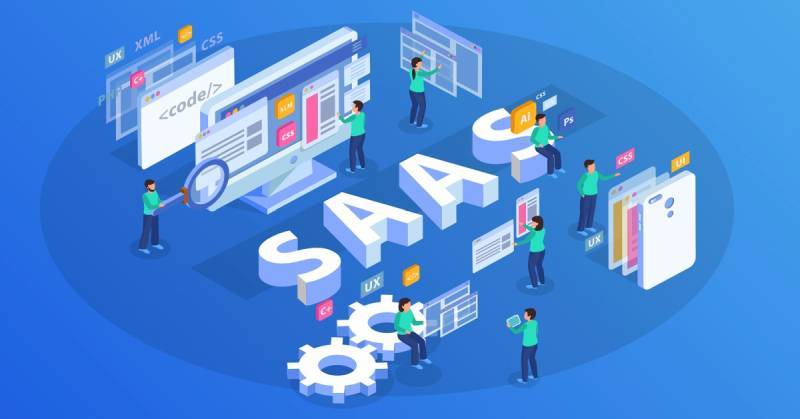

Apr 19, 2023 (SeoXnewsWire) — London, UK –Reports have shown that 89% of companies already use cloud services and it is projected that by 2026, the market size value amounts to $356.6 billion. These figures indicate that software SaaS application development could be a profitable venture and understanding the coming trends in SaaS is essential for success. In other words, with a high degree of probability, investments in the development of high-quality SaaS products will pay off. To stay ahead of the competition and build a successful SaaS product, one must comprehend the future of SaaS software and be up-to-date with new tools that are available.
The SaaS Model
The SaaS model is incredibly popular for businesses because the upfront cost is usually low and the benefits are plentiful. SaaS offers high availability and scalability, so companies can have access to the software whenever they need it and can be sure that their data will not get lost in case of server malfunctioning. Furthermore, SaaS offers subscription-based payment options which make budget management easier for businesses. However, creating SaaS products is no easy feat – a lot of coding skills combined with UI design are needed to make the product valuable. Standard SaaS agreements focus largely on topics such as resource utilization, user numbers, usage volume limits, and extracurricular services like training or integrations. All in all, SaaS enables businesses to increase productivity without wasting time setting up physical infrastructure.
The main trends in SaaS 2023-2024
James Clear’s distinction between goals and systems has never been more applicable than when it comes to the evolution of SaaS models. What began as a way to revolutionize software buying and pricing is now seeing exponential growth, expected toreach almost $1 trillion in market revenue by 2028. The software as a service niche already contains many good products, but it also has room for new projects. The main condition for success is an interesting idea, a useful project, and its high-quality implementation. A deep understanding of the market is an additional advantage of ordering from such experienced teams, as they can help you prioritize correctly and avoid many mistakes.
Mobile-First Development
SaaS products have seen a rapid surge in usage, requiring SaaS providers to quickly update their existing offerings for mobile compatibility. Looking ahead, SaaS companies should be investing in what is known as ‘mobile-first development’, meaning that SaaS products are first developed for smartphones and then adapted for PC use afterward. This is a crucial move in order to keep up with the times; anestimated 3.7 billion people worldwide would be using only smartphones by 2025 to access the web while only 69 million use PCs instead. Though SaaS platforms will still be available on PCs, this mobile-first approach provides SaaS providers an extra boost of opportunities to reach out further in today’s digital world.
Artificial intelligence
The SaaS platform is feeling the effects of AI integration in recent years. Despite this being a trend, many companies are less enthusiastic about it due to the potential risks associated with it. But in reality, trends such as machine learning and natural language processing present huge opportunities for SaaS. By employing artificial intelligence capabilities like human speech pattern recognition, SaaS businesses can enjoy higher levels of automation and security, as well as faster data handling. It is expected that resource-consuming industries such as social media, education, travel, and healthcare will be the most likely needers of AI-based solutions in the near future as they stand to benefit immensely from its applications.
Vertical SaaS
Unlike horizontal SaaS, this approach tailors to specific industry needs, allowing businesses to form tie-ups with their customers and offer them the best practices in their field. Not only will this model result in incredible customer service, but it also promises a hefty 8x return on customer acquisition costs when compared to more traditional cloud outlets. This is sure to provide a great alternative for companies looking for an edge over the cutthroat cloud marketplace. Additionally, vertical SaaS can help businesses create their own niche and increase their ROI several times over. In terms of potential opportunities – logistics, retail analytics, and healthcare BI software are prime examples that might find much value from adopting vertical cloud solutions. All in all, the vertical cloud looks set to remain one of the integral factors driving SaaS into its future 2020s growth cycle.
Blockchain
SaaS solutions have long been renowned for their ability to provide transparency and security throughout the SaaS lifecycle. However, SaaS platforms are still built on centralized databases and are thus vulnerable to cyberattacks. Blockchain technology presents an innovative solution that promises to bring SaaS market data security to the next level. Blockchain is a distributed system with constantly updated information and records that can be backed up across multiple networks, making it tough for malicious actors to gain access to unauthorized data. While blockchain is still a novelty in SaaS markets, its ability to provide greater security makes it one of the most promising technologies of the future.
Emphasis on safety
Data security has become a critical factor in the success of SaaS businesses. With digital transformation happening at an unprecedented speed, cyber risks have emerged that could spell disaster if left unchallenged. That is why experts like Gartner predict double-digit growth in spending on risk management solutions over the next few years, with security expenditures expected to exceed $188.3 billion by 2023. This increased focus on data protection will be particularly significant for SaaS companies pursuing cloud-based services, such as multi-cloud deployments and micro-SaaS unbundling. Developers of these services will have to factor in major security features into their product designs in order for SaaS businesses to mitigate risks and protect both themselves and their customers from data breaches.
Conclusion
The trends listed above should be taken into account by all companies that want to work on the SaaS model. That is, this applies not only to new products but also to SaaS migration. In any case, all companies that want to provide a competitive advantage for their products must use the best of today and follow the trends.
SaaS Developer Trends – 2022 and 2023
Aston Rhodes
Content Marketing Specialist at JatApp
Aston is an experienced content creator and marketing expert who writes about software development at JatApp. She has been helping authors to improve their blogs for over five years, enabling them to turn this hobby into a business. She enjoys researching and discussing technology-related topics and sharing her experiences with like-minded audiences. She also writes about digital marketing, business, and careers.


